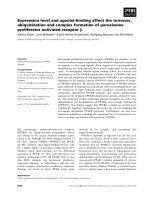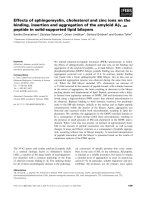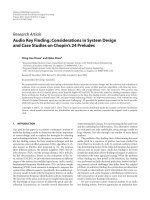Observing changes in lake level and glacial thickness on the tibetan plateau with the ICESat laser altimeter
Bạn đang xem bản rút gọn của tài liệu. Xem và tải ngay bản đầy đủ của tài liệu tại đây (5.33 MB, 177 trang )
Observing changes in lake level and glacial thickness on
the Tibetan Plateau with the ICESat laser altimeter
Vu Hien Phan
Observing changes in lake level and glacial thickness on
the Tibetan Plateau with the ICESat laser altimeter
Proefschrift
ter verkrijging van de graad van doctor
aan de Technische Universiteit Delft,
op gezag van de Rector Magnificus prof. ir. K.C.A.M. Luyben,
voorzitter van het College voor Promoties,
in het openbaar te verdedigen op Maandag 26 January 2015 om 15:00 uur
door
Vu Hien PHAN
Master of Engineering in Mapping, Remote Sensing and GIS
Ho Chi Minh City University of Technology, Vietnam
geboren te Sa Dec, Vietnam.
-i-
Dit proefschrift is goedgekeurd door de promotor: Prof. dr. M. Menenti
Copromotor: Dr. R.C. Lindenbergh
Samenstelling promotiecommissie:
Rector Magnificus,
voorzitter
Prof. dr. M. Menenti
Technische Universiteit Delft, promotor
Dr. R.C. Lindenbergh
Technische Universiteit Delft, copromotor
Prof. dr. M. Scaloni
Tongji University
Prof. dr. ir. Z. Su
Universiteit Twente
Prof. dr. ir. N.C. van de Giesen
Technische Universiteit Delft
Dr. J. Kropacek
Universität Tübingen
Dr. N. Gourmelen
The University of Edinburgh
Prof. dr. W.G.M. Bastiaanssen
Technische Universiteit Delft, reservelid
Copyright 2015 by Vu Hien Phan.
All rights reserved. No part of the material protected by this copyright notice may
be reproduced or utilized in any form or by any means, electronic, mechanical,
including photocopying, recording or by any information storage and retrieval
system, without the prior permission of the author.
ISBN 978-94-6186-426-0
Author email: or
- ii -
Preface
Many people contributed to the successful completion of this thesis in different
ways. I wish to express my sincere gratitude to all of them.
Firstly, I am extremely grateful to my co-promoter Dr. Roderik Lindenbergh.
You were always there to help and support me whenever I ran into a problem. I
think your support and commitment during my study made other PhDs jealous in
our section. In our weekly meetings, you always had excellent advice to give on
my technical problems. I really appreciate your patience in correcting my English
writing and the constructive feedback on how to write an effective article. Thank
you for all your help and support to extend my knowledge and experiences in
research.
Secondly, I would like to thank Prof. Massimo Menenti, for providing me with
the opportunity to carry out my research and for your continuous support. With
the extensive knowledge, you always gave me helpful ideas and provided me
with clear and in-depth answers to my scientific and technical problems. Also, I
would like to thank you for the constructive criticisms and relevant comments on
the content of this dissertation.
I want to thank the Vietnam Ministry of Education and Training and the CEOPAEGIS project on the Hydrology and Climatology of the Tibetan Plateau, project
no. 212921 of the European Commission FP7 program for funding this research.
Furthermore, I wish to thank my friends at the OLRS section: Ali Mousivand,
Hamid Reza Ghafarian Malamiri, and Seyed Enayat Hosseini Aria for sharing
knowledge and experiences in studying and living in Delft and contributed to a
nice and enjoyable life at TUDelft.
I am thankful to Lidwien De Jong, for all the support to process a lot of
documents in regularization enthusiastically. I am also very grateful to
Vietnamese students and all other colleagues here at TU Delft.
I am indebted to my mother in law for having taken care of my daughter in
Vietnam, to my lovely wife for being sympathetic and encouraging to me, and to
my beautiful daughter for still recognizing and loving me.
Last but not least, I wish to thank my lovely family and friends for their support
and encouragement.
- iii -
- iv -
Table of content
Preface .......................................................................................................... iii
Table of content.............................................................................................. v
Abbreviations ................................................................................................ ix
Summary ....................................................................................................... xi
Samenvatting................................................................................................ xv
Tóm tắt ......................................................................................................... xix
Chapter 1. INTRODUCTION .............................................................................. 1
1.1.
The water balance of the Tibetan Plateau ............................................... 2
1.2.
ICESat laser altimetry ............................................................................... 6
1.3.
Research question ................................................................................... 8
1.4.
Methodology ........................................................................................... 8
1.5.
Organization of this thesis ....................................................................... 9
Chapter 2. EXPLOITED REMOTE SENSING DATA ............................................. 11
2.1.
Introduction ........................................................................................... 12
2.2.
ICESat/GLAS data ................................................................................... 12
2.2.1. ICESat mission .................................................................................. 12
2.2.2. GLAS data products .......................................................................... 16
2.2.3. ICESat GLA14 land surface elevation data ....................................... 16
2.3.
Other remote sensing products ............................................................. 20
2.3.1. GLIMS / CAREERI glacier mask ......................................................... 20
2.3.2. MODIS land-water mask .................................................................. 22
2.3.3. SRTM DEM ....................................................................................... 23
2.3.4. HydroSHEDS hydrographic data ....................................................... 23
2.3.5. Landsat TM images .......................................................................... 24
2.4.
Conclusions ............................................................................................ 25
Chapter 3. ASSESSING GLACIAL THICKNESS CHANGES AT THE TIBETAN PLATEAU
USING ICESAT LASER ALTIMETRY .................................................................. 27
3.1.
Introduction ........................................................................................... 28
3.2.
Methodology ......................................................................................... 29
3.2.1. Estimating surface slope and roughness from SRTM DEM .............. 30
-v-
3.2.2. Determining a sampled glacial area................................................. 32
3.2.3. Identifying a glacial elevation difference ......................................... 32
3.2.4. Different settings with respect to slope and roughness ................... 34
3.2.5. Obtaining mean glacial elevation differences .................................. 35
3.2.6. Estimating a temporal glacial thickness change trend ..................... 36
3.3.
Results .................................................................................................... 37
3.3.1. Overall glacial thickness changes: Tibetan Plateau and its basins ... 40
3.3.2. Impact of orientation on glacial thickness change ........................... 42
3.4.
Discussion .............................................................................................. 45
3.4.1. Exploring terrain surface criteria ...................................................... 45
3.4.2. State of the GLIMS glacier mask....................................................... 47
3.4.3. Glacial thickness changes for sub-regions ........................................ 48
3.4.4. Representativeness of an observed glacial area .............................. 50
3.5.
Conclusions ............................................................................................ 51
Chapter 4. ESTIMATING ANNUAL LAKE LEVEL TRENDS ON THE TIBETAN
PLATEAU ...................................................................................................... 53
4.1.
Introduction ........................................................................................... 54
4.2.
Methodology.......................................................................................... 56
4.3.
Results .................................................................................................... 59
4.3.1. Annual lake level trends all over the Tibetan Plateau ...................... 59
4.3.2. Case studies: comparing GLAS results to LEGOS data ...................... 63
4.4.
Discussion .............................................................................................. 64
4.4.1. Disadvantages of the supporting image data: the 250 m MODIS
land-water mask and Landsat data ............................................................. 65
4.4.2. Anomalies in the candidate ICESat lake elevations .......................... 65
4.4.3. Determining the threshold value in the RANSAC algorithm ............. 66
4.4.4. Link to physical processes ................................................................. 66
4.5.
Conclusions ............................................................................................ 67
Chapter 5. ASSESSING SEASONAL LAKE LEVEL VARIATIONS USING ICESAT LASER ALTIMETRY 69
5.1.
Introduction ........................................................................................... 70
5.2.
Methodology.......................................................................................... 70
5.2.1. Estimating lake level trends per season ........................................... 71
5.2.2. Obtaining seasonal lake level variations .......................................... 72
- vi -
5.3.
Results.................................................................................................... 74
5.3.1. Annual trends based on lake levels from fixed seasons ................... 74
5.3.2. Lake level changes during the monsoon and the dry season ........... 76
5.3.3. Case studies ...................................................................................... 77
5.4.
Discussion .............................................................................................. 79
5.5.
Conclusions ............................................................................................ 79
Chapter 6. IDENTIFYING GEOMETRIC LINKS BETWEEN GLACIERS AND LAKES ON
THE TIBETAN PLATEAU ................................................................................. 81
6.1.
Introduction ........................................................................................... 82
6.2.
Methodology ......................................................................................... 83
6.2.1. Determining the catchment of a Tibetan lake.................................. 84
6.2.2. Identifying connections between glaciers and lakes ........................ 84
6.2.3. Calculating the area of a lake catchment ........................................ 88
6.2.4. Computing the total area of glaciers draining into a lake ............... 90
6.2.5. Defining the geometric dependency of a lake on glacial runoff ....... 90
6.3.
Results.................................................................................................... 91
6.3.1. Lakes with glacial runoff at the Tibetan Plateau.............................. 91
6.3.2. Case studies ...................................................................................... 95
6.4.
Discussion .............................................................................................. 99
6.4.1. The hydrological interpretation of geometric dependency on glacial
runoff ....................................................................................................... 100
6.4.2. Details on computing the geometric dependency of lakes on glacial
runoff ....................................................................................................... 101
6.5.
Conclusions .......................................................................................... 107
Chapter 7 .................................................................................................... 109
CONCLUSIONS ............................................................................................ 109
7.1.
Achievements ...................................................................................... 110
7.2.
Recommendations ............................................................................... 115
7.2.1. Data processing .............................................................................. 115
7.2.2. Upcoming missions ........................................................................ 116
7.3.
Further research .................................................................................. 117
Bibliography ............................................................................................... 119
Websites..................................................................................................... 126
- vii -
Publications ................................................................................................ 127
Appendix A ................................................................................................. 129
Table A: Rates of glacial thickness changes on the Tibetan Plateau between
2003 and 2009 ........................................................................................... 129
Appendix B .................................................................................................. 135
Table B1: Rates of individual lake level changes between 2003 and 2009 on
the Tibetan Plateau .................................................................................... 135
Table B2: The list of additional Tibetan observed lakes when the threshold
value increases ........................................................................................... 144
Appendix C .................................................................................................. 145
Table C: Lakes dominated by glaciers on the Tibetan Plateau ................... 145
- viii -
Abbreviations
ASCII
American Standard Code for Information Interchange
CAREERI
Cold and Arid Regions Environmental and Engineering
Research Institute
DEM
Digital Elevation Model
EMG96
Earth Gravitational Model 1996
EMG2008
Earth Gravitational Model 2008
FWHM
Full Width at Half Maximum pulse
GLAS
Geoscience Laser Altimeter System
GLIMS
Global Land Ice Measurements from Space
GRACE
Gravity Recovery And Climate Experiment
HDF
Hierarchical Data Format
HydroSHEDS
Hydrological data and maps based on SHuttle Elevation
Derivatives at multiple Scales
ICESat
Ice, Cloud, and Land Elevation Satellite
MODIS
Moderate Resolution Imaging Spectroradiometer
NASA
National Aeronautics and Space Administration
NSIDC
National Snow and Ice Data Centre
SRTM
Shuttle Radar Topography Mission
TOPEX/Poseidon
Topography Experiment/Poseidon
UTC
Universal Coordinated Time
WGS84
World Geodetic System 1984
- ix -
-x-
Summary
Observing changes in lake level and glacial thickness on the Tibetan Plateau
with the ICESat laser altimeter
The Tibetan Plateau is a vast, elevated plateau in Central Asia. It occupies an area
of ~2.5 million km2 and has an average elevation of over 4,500 m. The Tibetan
Plateau is not only the highest and largest plateau of the world, but also contains a
large amount of glaciers. In addition, there are thousands of lakes in this region.
Most of them supply fresh water for people, livestock and agriculture while some
are salt water lakes. The Tibetan Plateau is also the origin of Asia’s big rivers
such as Brahmaputra, Ganges, Indus, Mekong, Salween, Yellow River, and
Yangtze. Glacial melt water supplies large inflow for the rivers during the
summer monsoon and is a primary water source in the dry season. It means that
the Tibetan Plateau keeps the water resources under control for Southeast Asia,
the most densely populated region on Earth. However, recent research reported
that the glaciers have been retreating significantly in the last decades. That is
expected to affect the water storage of this region. Therefore, understanding
hydrologic processes and quantifying the water storage of the Tibetan Plateau is
essential.
In general, the water storage of the Tibetan Plateau is determined by precipitation,
surface runoff, evaporation and infiltration. Due to the vastness, high relief and
the complicated climate, only a limited number of hydrometeorologic gauge
measurements are available in this region. Thus it is difficult to quantify this
water storage. However, the net annual water storage of a lake or river basin,
considered as a simple water balance model, is one component of the total water
storage of the Tibetan Plateau. Changes in water storage of open water bodies can
be assessed by analyzing changes in their water levels. Moreover, one of the
variables directly affecting water levels of lakes and rivers on the Tibetan Plateau
is glacial melt water. Therefore, monitoring changes in glacial thickness and
water level is a potential useful contribution to the understanding of the
hydrologic processes and the water balance of the Tibetan Plateau.
In January 2003, the ICESat satellite was launched for measuring ice sheet mass
balance, cloud and aerosol heights, as well as land topography and vegetation
structure. The available ICESat/GLAS-derived land surface elevations have a
vertical accuracy at the decimeter level over flat terrain and a horizontal accuracy
in the order of meters. Each GLAS waveform was the result of the interaction of
the emitted Gaussian pulse with the terrain surface within a ~70 m diameter
footprint, much smaller than for example radar footprints. In addition, ICESat
only obtained measurements along track with an along track distance between
- xi -
Summary
consecutive footprints of 170 m. This small footprint makes the ICESat/GLAS
laser altimeter more advantageous in monitoring changes in lake level and glacial
thickness on the Tibetan Plateau than other remote sensing techniques.
The changes in lake level and glacial thickness can be converted to water
volumes that can be used as input of water balance models. These contribute to
improve the understanding of changes in the water storage of the Tibetan Plateau.
That is why observing changes in lake level and glacial thickness on the Tibetan
Plateau with the ICESat laser altimeter is reasonable. The research consists of
three main parts: i) monitoring lake level changes, ii) monitoring glacial thickness
changes and iii) assessing relationships between changes in lake level and glacial
thickness.
Monitoring changes in lake levels: the ICESat GLA14 land surface elevation data
in combination with the MODIS land-water mask was used to obtain water level
variations of Tibetan lakes. The GLA14 elevations representing lake surface
elevations were basically selected by using the lake outlines, derived from the
MODIS land-water mask. For each ICESat sampled lake, anomalies in observed
surface elevations due to e.g. clouds, saturation or surface characteristics, were
removed using the RANSAC algorithm. Then the mean elevations corresponding
to the ICESat acquisition times were determined. They were representative for
lake levels during the observed period. Subsequently, a temporal lake level trend
was estimated by linear regression. The results indicated that water level
variations of 154 lakes spread all over the Tibetan Plateau between 2003 and
2009 could be obtained. Moreover, most of the lakes with a serious downwards
trend are in the southern Tibetan Plateau and along the Himalaya mountain range
and, vice versa, most of the lakes with a positive water level trend are in the inner
Tibetan Plateau.
In addition, GLA14 elevations were grouped into three seasonal datasets
following to the ICESat acquisition schedule: late dry season, wet season, and
early dry season. Yearly trends were estimated using lake levels in the same
season and different years. The results indicated that seasonal influences were
more obvious in the South of the Tibetan Plateau than those in the Northwest.
The seasonal influence on lake level gradually decreased from the Southeast to
the Northwest of the Tibetan Plateau. These results correspond to trends in
precipitation, temperature and humidity as documented in recent research on
climate change at the Tibetan Plateau.
Monitoring changes in glacial thickness: the ICESat GLA14 land surface
elevation data in combination with the SRTM DEM and the GLIMS glacier mask
was used to obtain changes in glacial thickness. Here, the approach for estimating
- xii -
Observing changes in lake level and glacial thickness on the Tibetan
Plateau with the ICESat laser altimeter
glacial thickness was to estimate the difference between the GLA14 elevation and
the reference SRTM DEM. By considering where ICESat sampled glaciers,
ICESat-sampled nearby glaciers having similar orientation were grouped into
observed glacial areas. Accordingly the GLA14 elevations on these glacial areas
were selected. For each glacial area, uncertain GLAS elevations were removed,
based on criteria that were also used for lakes, while in addition, also the terrain
slope and roughness were considered. Subsequently, the mean elevation
difference between the remaining GLA14 elevations and the SRTM DEM,
corresponding to each ICESat acquisition time, was determined. Based on these
mean differences, a temporal trend of glacier thinning or thickening between
2003 and 2009 was estimated. As a result trends in thickness change for 90
glacial areas on the whole Tibetan Plateau between 2003 and 2009 were obtained.
Most of the observed glacial areas at the Tibetan Plateau experienced serious
thinning, except the North-facing glaciers of the western Kunlun Mountains.
Moreover, glacial thickness changes appeared to be strongly dependent on the
relative position in a mountain range. Conversely most North-facing glaciers
increased in thickness, although some decreased but in that case at a slower rate
than its South-facing counterpart.
Assessing relationships between changes in glacial thickness and lake level:
geometric links between glaciers and lakes on the Tibetan Plateau were
determined by applying a surface flow network analysis in catchments with both
a lake and a glacier. The surface flow network was based on the HydroSHEDS
product which was derived from the SRTM DEM, but needed corrections at
several locations. The results indicated that 25.3% of the glaciers release their
melt water directly to 244 lakes. Moreover, the ratio between the total area of
glaciers draining into a lake and the area of its catchment was introduced as a
proxy for the dependency of a lake on glacial runoff. The results clearly listed
which lakes are more or less dependent on glacial runoff and therefore indicate
which lakes are expected to be strongly affected by the shrinkage of the glaciers
on the Tibetan Plateau.
Because of its orbit constellation, ICESat only sparsely sampled glaciers and
lakes on the Tibetan Plateau were observed. Change rates in glacial thickness and
lake level between 2003 and 2009 on the Tibetan Plateau derived from the
ICESat laser altimetry were computed. In addition, the geometric dependency of
Tibetan lakes and glacial runoff represents levels of the dependency of a Tibetan
lake on glacial runoff. An analysis of spatial patterns in water volume changes in
glacial areas and lakes could be performed to determine a possible correlation.
Results of such analysis would be a first additional step in the understanding of
hydrological processes on the Tibetan Plateau.
- xiii -
Summary
- xiv -
Samenvatting
Het waarnemen met de ICESat laserhoogtemeter van veranderingen in
waterniveaus van meren en diktes van gletsjers op het Tibetaanse Plateau
Het Tibetaans Plateau is een uitgestrekte hoogvlakte in Centraal-Azië. Het heeft
een oppervlakte van ~2.5 miljoen km2 en de gemiddelde hoogte is meer dan
4,500 meter. Het Tibetaanse Plateau is niet alleen de grootste en meest
hooggelegen hoogvlakte van de wereld, maar bevat ook duizenden gletsjers en
meren. De meeste meren zijn een bron van zoet water voor mensen, vee en
landbouw, maar sommige meren zijn zout. Op het Tibetaanse Plateau
ontspringen ook een aantal grote Aziatische rivieren, zoals de Brahmaputra, de
Ganges, de Indus, de Mekong, de Salween, de Gele Rivier en de Yangtze.
Smeltwater van de vele gletsjers stroomt massaal de rivieren in tijdens het
zomermoesson en is de voornaamste bron van water in het droge seizoen. Op
deze manier controleert het Tibetaanse Plateau de watervoorraden van ZuidoostAzië, één van de meest dichtbevolkte gebieden op aarde. Recent onderzoek toont
echter aan dat de gletsjers smelten, wat de waterhuishouding zal beïnvloeden. Om
de verschillende hydrologische processen en hun mogelijke gevolgen te
begrijpen, is het daarom essentiëël om mogelijke veranderingen in
watervoorraden en watertransport op het Tibetaanse Plateau te kwantificeren.
De waterbalans van het Tibetaanse Plateau hangt af van neerslag, afvoer,
verdamping en infiltratie. Door de hoogte, de ruwheid van het terrein en het barre
klimaat zijn slechts beperkt metingen op locatie mogelijk. Daarom is het moeilijk
om inzicht te krijgen in de totale waterbalans. Het oppervlaktewater, water in
meren en rivieren, vormt echter een belangrijk onderdeel van de totale
waterbalans. Veranderingen in de hoeveelheid oppervlaktewater kunnen worden
afgeleid uit veranderingen in de waterstanden. Deze waterstanden worden
ondermeer beinvloedt door de aanvoer van smeltwater van gletsjers. Daarom kan
het monitoren van veranderingen in waterstanden en diktes van gletsjers
bijdragen aan beter inzicht in de waterbalans van het Tibetaanse Plateau.
In januari 2003 werd de ICESat satelliet gelanceerd met als hoofddoel het meten
aan de massabalans van de ijskappen. Daarnaast moest de satelliet ook bijdragen
aan het bepalen van de hoogtes van wolken en het wereldwijd in kaart brengen
van de structuur van onze vegetatie. Om deze metingen te kunnen uitvoeren
gebruikte ICESat de GLAS laser hoogtemeter. ICESat was actief tussen 2003 en
2009. De ICESat/GLAS hoogtemetingen hebben een verticale nauwkeurigheid in
de orde van een decimeter over vlak terrein en een horizontale nauwkeurigheid in
de orde van enkele meters. Het terrein dat door een enkel GLAS lasersignaal
wordt belicht en daardoor ingemeten, heeft een diameter van ongeveer 70 m, veel
- xv -
Samenvatting
kleiner dan de voetafdrukken van radar altimeters. ICESat kon alleen direct onder
zijn eigen baan meten, maar leverde wel elke 170 m een nieuwe meting af. Door
zijn kleine voetafdruk zijn de ICESat/GLAS metingen in principe beter geschikt
voor het in kaart brengen van veranderingen in waterstanden en diktes van
gletsjers op het Tibetaanse Plateau dan andere remote sensing technieken.
De veranderingen in de waterstanden van meren en diktes van gletsjers kunnen
direct worden omgezet in watervolumes, die weer kunnen worden gebruikt als
invoer voor waterbalans modellen. Zulke modellen dragen bij aan het begrip van
veranderingen in de waterhuishouding van het Tibetaanse Plateau. Daarnaast
levert directe analyse van de veranderingen ook veel nieuwe informatie op. Dit
geeft het potentiële nut aan van het onderzoek beschreven in dit proefschrift. Het
onderzoek bestaat uit drie delen: i) het monitoren van waterstanden in meren, ii)
het monitoren van veranderingen in de dikte van gletsjers, en, iii) het bepalen van
verbanden tussen meren en gletsjers.
Het monitoren van waterstanden in meren: de ICESat GLA14 landhoogtes in
combinatie met het MODIS land-water sjabloon worden gebruikt om
waterstanden van Tibetaanse meren te verkrijgen. Om GLA14 metingen van het
wateroppervlak te krijgen, is gekeken welke GLA14 metingen binnen de omtrek
van een meer vallen. Hiervoor is het MODIS land-water sjabloon gebruikt.
Vervolgens worden foute metingen verwijderd met behulp van het RANSAC
algoritme. Zulke fouten metingen worden onder meer veroorzaakt door
bewolking. Uit de correcte metingen wordt een gemiddelde waterstand bepaald,
die gekoppeld wordt aan de tijd dat ICESat het meer passeerde. Bij voldoende
passages kan bovendien een trend worden geschat door de verschillende
waterstanden die voor een enkel meer verkregen ziijn. In totaal konden op deze
manier trends voor 154 verschillende meren worden verkregen, verspreid over het
Tibetaans Plateau. De meeste meren die gemiddeld zakken bevinden zich in het
zuiden van Tibet en langs de Himalaya, terwijl de meren in het midden van Tibet
juist gemiddeld stijgen tussen 2003 en 2009.
De waterstanden die aan de hand van de GLA14 metingen bepaald werden,
konden gegroepeerd worden in drie verschillende seizoenen, die corresponderen
met de jaargetijden waarin ICESat actief was: het late droge seizoen, het natte
seizoen, en het begin van het droge seizoen. Trends per seizoen werden geschat
en deze werden vergeleken met trends verkregen uit alle waterstanden tesaman.
De resultaten geven aan dat seizoensinvloeden sterker zijn in het zuidoosten van
Tibet en dat deze invloed afneemt richting noordwesten. Deze resultaten komen
overeen met trends in neerslag, temperatuur en vochtigheid zoals door anderen
zijn gedocumenteerd in recent onderzoek over klimaatverandering in Tibet.
- xvi -
Het waarnemen met de ICESat laserhoogtemeter van veranderingen in
waterniveaus van meren en diktes van gletsjers op het Tibetaanse
Plateau
Het monitoren van veranderingen in de dikte van gletsjers: de ICESat GLA14
hoogtemetingen zijn gebruikt in combinatie met het SRTM hoogtemodel en het
GLIMS gletsjer sjabloon om veranderingen in diktes van gletsjers te schatten.
Daartoe is steeds het verschil bepaald tussen de GLA14 hoogte en de SRTM
hoogte op dezelfde locatie. Hoogtemetingen van verschillende gletsjers werden
daarbij gegroepeerd als de gletsjers bij elkaar in de buurt lagen en bovendien op
een soortgelijke manier waren georiënteerd. Deze procedure resulteerde in een
beperkt aantal gletsjer zones. Uit alle correct geachte verschillen tussen GLA14
en SRTM werd vervolgens voor elke gletsjerzone een trend geschat die aangeeft
hoeveel ijs er gemiddeld per jaar verloren ging of bijkwam tussen 2003 en 2009.
Op deze manier werden trends voor de verandering in de dikte van gletsjers
verkregen voor 90 verschillende gletsjer zones. De resultaten laten zien dat in de
meeste zones de gletsjer flink dunner worden, met uitzondering van de op het
noorden georiënteerde gletsjers in de westelijke Kunlun. Bovendien blijkt dat
veranderingen sterk afhankelijk zijn van de relatieve positie van een gletsjerzone
in een gebergte.
Het bepalen van verbanden tussen meren en gletsjers: geometrische verbanden
tussen gletsjers en meren op het Tibetaanse Plateau werden bepaald aan de hand
van een netwerkanalyse van het volledige Tibetaanse riviernetwerk. Als invoer
voor deze analyse is het zogenaamde HydroSHEDS riviernetwerk product
gebruikt, dat op zijn beurt weer is afgeleid van het SRTM hoogtemodel. Wel
waren correcties noodzakelijk op verschillende locaties. De resultaten geven aan
dat 25,3% van de gletsjers hun smeltwater direct afvoeren naar 244 meren.
Bovendien kon de verhouding tussen de totale oppervlakte van alle gletsjers die
afwateren in een meer en de oppervlakte van het toevoersgebied van dat meer
worden bepaald als proxy voor de afhankelijkheid van een meer van
gletsjerwater. De resultaten laten duidelijk zien welke meren meer of minder
afhankelijk zijn van gletsjerwater en welke meren daarom naar verwachting
sterker zullen worden beïnvloed door het krimpen van de gletsjers op de
Tibetaanse hoogvlakte.
Door de beperkingen in de meetcapaciteit van ICESat, heeft ICESat slechts een
beperkt aantal gletsjers en meren op het Tibetaanse Plateau kunnen waarnemen.
Op grond van alle beschikbare metingen zijn trends bepaald in de verandering in
waterstanden van veel meren en diktes van 90 gletsjer zones. Daarnaast is de
geometrische afhankelijkheid van gletsjerwater bepaald voor alle Tibetaanse
meren. Een spatiële analyse van deze verschillende veranderingen in water
volume in vergletsjerde gebieden kan worden uitgevoerd om een mogelijke
correlatie te bepalen. De resultaten van zo’n analyse zouden een eerste volgende
- xvii -
Samenvatting
stap kunnen zijn om verdere verbanden in de waterhuishouding van het
Tibetaanse Plateau te kunnen onthullen.
- xviii -
Tóm tắt
Giám sát những biến đổi mực nước hồ và độ dày băng trên Cao nguyên Tây
Tạng với thiết bị đo cao bằng laser từ vệ tinh ICESat
Cao nguyên Tây Tạng là một cao nguyên cao và rộng lớn ở Trung tâm châu Á.
Nó chiếm diện tích ~2.5 triệu km2 và có cao độ trung bình trên 4,500 m. Cao
ngun Tây Tạng không những là cao nguyên cao nhất và rộng nhất trên thế giới,
mà còn chứa một lượng lớn băng. Ngồi ra, có hàng ngàn hồ trên khu vực này.
Hầu hết những hồ này cung cấp nước ngọt cho người dân, thú ni và nơng
nghiệp trong khi đó một số là hồ nước mặn. Cao nguyên Tây Tạng cũng là nguồn
của những con sông lớn của châu Á như Brahmaputra, Ganges, Indus, Mekong,
Salween, Yellow River, và Yangtze. Nước băng tan cung cấp một lượng lớn cho
các con sông trong suốt đợt gió mùa vào mùa hè và là nguồn nước thiết yếu trong
mùa khơ. Điều này có nghĩa là Cao nguyên Tây Tạng giữ những nguồn nước
quan trọng cung cấp cho khu vực Đơng Nam Á, khu vực có mật độ dân số cao
nhất thế giới. Tuy nhiên, những nghiên cứu gần đây báo cáo rằng diện tích băng
đã mất dần một cách rõ rệt trong vài thập kỷ qua. Điều này được cho là ảnh
hưởng đến trữ lượng nước của khu vực này. Do vậy, việc hiểu biết những quy
trình thủy văn và định lượng trữ lượng nước của Cao nguyên Tây Tạng là cần
thiết.
Nhìn chung, trữ lượng nước của Cao nguyên Tây Tạng được xác định bởi lượng
mưa, dòng chảy bề mặt, sự bốc hơi nước và sự thẩm thấu. Do địa hình cao, rộng
lớn và khí hậu phức tạp, chỉ có một lượng giới hạn các trạm khí tượng thủy văn ở
khu vực này. Thế nên, rất khó khăn để định lượng trữ lượng nước này. Tuy nhiên,
trữ lượng tĩnh của một lưu vực hồ hoặc sơng, được xem như một mơ hình cân
bằng nước đơn giản, là một thành phần của tổng trữ lượng nước của Cao nguyên
Tây Tạng. Những biến đổi trữ lượng nước của những nguồn nước mặt có thể
được đánh giá bằng cách phân tích những biến đổi mực nước của chúng. Hơn
nữa, một trong những yếu tố ảnh hưởng trực tiếp đến mực nước hồ và sông trên
Cao nguyên Tây Tạng là nước băng tan. Do đó, việc giám sát những biến đổi độ
dày băng và mực nước đóng góp rất hữu ích để hiểu những quy trình thủy văn và
cân bằng nước của Cao nguyên Tây Tạng.
Tháng 1 năm 2003, vệ tinh ICESat được phóng để đo cân bằng khối của các tảng
băng, độ cao của mây và aerosol, cũng như cấu trúc thực vật và địa hình mặt đất.
Dữ liệu độ cao bề mặt đất từ thiết bị đo cao bằng laser GLAS trên vệ tinh ICESat
có độ chính xác theo phương đứng ~10 cm trên địa hình phẳng và độ chính xác
theo phương ngang ~5 m. Footprint thể hiện cho diện tích tương tác trên bề mặt
địa hình của một xung Gauss được phát đi để thực hiện trị đo. Footprint từ phép
đo cao bằng xung laser được phát từ GLAS trên vệ tinh ICESat có đường kính
- xix -
Tóm tắt
~70 m, nhỏ hơn nhiều so với các footprints từ phép đo cao bằng xung radar trên
các vệ tinh khác như Topex/Poseidon, Jason-1&2, hoặc ENVISat. Ngoài ra,
ICESat chỉ thu được các trị đo dọc theo tuyến với khoảng cách dọc tuyến giữa hai
footprints liên tiếp là 170 m. Với đặc tính footprint nhỏ, thiết bị đo cao bằng laser
ICESat/GLAS có nhiều ưu điểm trong việc giám sát những biến đổi mực nước và
độ dày băng trên Cao nguyên Tây Tạng hơn những kỹ thuật viễn thám khác.
Những biến đổi mực nước và độ dày băng có thể được chuyển đổi thành các thể
tích nước mà có thể được sử dụng như thơng số đầu vào của các mơ hình cân
bằng nước. Những điều này góp phần nâng cao sự hiểu biết về những biến đổi trữ
lượng nước của Cao ngun Tây Tạng. Đó là lí do việc giám sát những biến đổi
mực nước và độ dày băng trên Cao nguyên Tây Tạng với thiết bị đo cao bằng
laser trên vệ tinh ICESat là cần thiết. Nghiên cứu này bao gồm ba phần chính: i)
giám sát biến đổi mực nước hồ, ii) giám sát biến đổi độ dày băng, và iii) đánh giá
những mối quan hệ giữa những biến đổi mực nước và độ dày băng.
Giám sát biến đổi mực nước: dữ liệu cao độ bề mặt đất ICESat GLA14 kết hợp
với mặt nạ nước mặt MODIS được sử dụng để lấy những biến động mực nước
của các hồ trên Cao nguyên Tây Tạng. Về cơ bản, dữ liệu độ cao GLA14 thể hiện
cao độ bề mặt nước được chọn bằng cách sử dụng đường bao của hồ, trích lọc từ
mặt nạ nước mặt MODIS. Với mỗi hồ được ICESat lấy mẫu, những dị thường
trong tập cao độ bề mặt do mây, sự bảo hịa của tín hiệu phản hồi, hoặc các đặc
tính bề mặt tương tác được loại bỏ bằng cách áp dụng giải thuật RANSAC. Sau
đó, những cao độ trung bình tương ứng với những thời điểm ICESat thu thập dữ
liệu được xác định. Chúng thể hiện cho những mực nước trung bình trong suốt
giai đoạn giám sát. Theo đó, xu hướng mực nước hồ theo thời gian được ước tính
bằng mơ hình hồi quy tuyến tính. Những kết quả chỉ ra rằng giám sát được biến
đổi mực nước của 154 hồ trải khắp Cao nguyên Tây Tạng giai đoạn năm 2003 và
2009. Hơn nữa, hầu hết các hồ có xu hướng giảm mực nước nghiêm trọng ở phía
nam của Cao nguyên Tây Tạng và dọc theo dải núi Himalaya, ngược lại hầu hết
các hồ có xu hướng tăng mực nước ở bên trong Cao nguyên.
Ngoài ra, dữ liệu cao độ GLA14 được nhóm thành ba tập dữ liệu theo mùa dựa
trên lịch trình thu thập dữ liệu của ICESat: cuối mùa khô, mùa ẩm ướt, và đầu
mùa khô. Những xu hướng biến đổi mực nước hồ hàng năm được ước lượng theo
cùng một mùa và giữa các mùa trong năm. Những kết quả chỉ ra rằng những ảnh
hưởng của mùa đối với mực nước hồ ở phía nam của Cao nguyên Tây Tạng rõ
ràng hơn ở phía tây bắc. Ảnh hưởng của mùa đối với mực nước giảm dần đều từ
phía đơng nam đến phía tây bắc của Cao nguyên Tây Tạng. Những kết quả này
phù hợp với những xu hướng biến đổi lượng mưa, nhiệt độ và độ ẩm được trình
bày trong có nghiên cứu gần đây về biến đổi khí hậu trên Cao nguyên Tây Tạng.
- xx -
Giám sát những biến đổi mực nước hồ và độ dày băng trên Cao nguyên
Tây Tạng với thiết bị đo cao bằng laser từ vệ tinh ICESat
Giám sát biến đổi độ dày băng: dữ liệu độ cao bề mặt đất ICESat GLA14 kết hợp
với mơ hình độ cao số SRTM và mặt nạ băng GLIMS được sử dụng để thu được
những biến đổi độ dày băng. Ở đây, hướng tiếp cận cho việc ước lượng độ dày
băng là ước lượng sự khác biệt giữa cao độ bề mặt đất GLA14 và mơ hình độ cao
số SRTM tham chiếu. Bằng cách xem xét những khu vực ICESat lấy mẫu những
khối băng, những khối băng được ICESat lấy mẫu nằm kề nhau và có cùng hướng
được nhóm lại thành những khu vực băng được lấy mẫu. Theo đó, những cao độ
GLA14 trên những khu vực băng này được chọn. Với mỗi khu vực băng được
giám sát, những trị đo GLAS không chắc chắn được loại dựa trên những đặc tính
được áp dụng cho hồ, tuy nhiên ngoài ra, độ dốc và độ gập ghềnh bề mặt địa hình
cũng được xem xét. Theo đó, trị đo trung bình của sự khác biệt cao độ giữa
những cao độ GLA14 được chấp nhận và mô hình độ cao số SRTM được xác
định, tương ứng với mỗi thời điểm thu thập dữ liệu của ICESat. Dựa trên những
trị đo trung bình của sự khác biệt cao độ này, xu hướng băng mỏng đi hay dày lên
theo thời gian được ước tính bằng mơ hình hồi quy tuyến tính. Kết quả là ước tính
được những xu hướng biến đổi độ dày của 90 khu vực băng trên Cao nguyên Tây
Tạng từ năm 2003 đến 2009. Hầu hết những khu vực băng được giám sát trên
Cao nguyên Tây Tạng đang trải qua việc mỏng dần nghiêm trọng, ngoại trừ
những khối băng ở những ngọn núi phía tây Kunlun. Những biến đổi độ dày băng
diễn ra phụ thuộc rất nhiều vào vị trí tương đối ở một dải núi. Ngồi ra, hầu hết
những khối băng hướng về phía bắc có xu hướng tăng độ dày, mặc dù một số có
xu hướng giảm nhưng trong những trường hợp đó thì tốc độ mỏng dần thấp hơn
so với tốc độ mỏng dần của khu vực băng tương ứng hướng về phía nam.
Đánh giá những mối quan hệ giữa biến đổi mực nước và biến đổi độ dày băng:
những liên kết hình học giữa những khối băng và hồ trên Cao nguyên Tây Tạng
được xác định bằng cách áp dụng phân tích mạng dòng chảy bề mặt trong những
lưu vực đối với mỗi khối băng và mỗi hồ. Mạng dòng chảy bề mặt được trích lọc
từ sản phẩm dữ liệu thủy văn HydroSHEDS được tạo ra từ mơ hình độ cao số
SRTM, tuy nhiên cần hiệu chỉnh ở vài khu vực. Những kết quả chỉ ra rằng 25.3%
của tổng diện tích bề mặt băng giải phóng nước băng tan chảy trưc tiếp đến 244
hồ. Hơn nữa, tỉ số giữa tổng diện tích bề mặt băng có nước băng tan chảy xuống
một hồ và diện tích lưu vực của hồ đó được giới thiệu như một biến tham khảo
cho sự phụ thuộc của một hồ vào dòng chảy nước băng tan. Những kết quả liệt kê
rõ ràng những hồ nào phụ thuộc nhiều hơn hoặc ít hơn vào dịng chảy nước băng
tan và như vậy xác định được những hồ nào được mong đợi bị ảnh hưởng nhiều
bởi sự co lại của các khối băng trên Cao nguyên Tây Tạng.
Do đặc điểm quỹ đạo vệ tinh, các khối băng và hồ được ICESat lấy mẫu nằm rải
rác trên khắp Cao nguyên Tây Tạng. Những tốc độ biến đổi mực nước và độ dày
băng giai đoạn năm 2003 và 2009 được ước tính dựa trên dữ liệu đo cao bằng
laser từ vệ tinh ICESat. Ngoài ra, mức độ phụ thuộc của những hồ trên Cao
- xxi -
Tóm tắt
ngun Tây Tạng vào dịng chảy nước băng tan cũng được xác định. Phân tích
kiểu mẫu khơng gian những biến đổi thể tích nước của những khối băng và hồ có
thể được thực hiện để xác định mức độ tương quan giữa chúng. Những kết quả
của phân tích như thế sẽ là bước bổ sung đầu tiên để hiểu những quy trình thủy
văn trên Cao nguyên Tây Tạng.
- xxii -
Chapter 1
INTRODUCTION
This chapter presents scientific reasons and methods for monitoring changes in
glacial thickness and lake level on the Tibetan Plateau. First we introduce the
Tibetan Plateau and the importance of studying the water balance of this region.
The Tibetan Plateau has the largest glacier-covered area outside the Poles,
containing ~37,000 glaciers that together occupy an area of ~56,560 km2. There
are thousands of lakes on this region, ~900 lakes of which have an area of over 1
km2. It is also known as The Water Tower of Asia as it is the origin of major
rivers that flow to Bangladesh, Burma, Cambodia, China, India, Nepal, Pakistan,
Thailand and Vietnam. Thus the water of the Tibetan Plateau is an important
fresh water source for more than one billion people living in the basins of these
rivers. In general, glacial melt water from mountains feeds lakes and rivers on the
Tibetan Plateau. Moreover, changes in water storage of open water bodies can be
assessed by analyzing changes in their water levels. Therefore, estimating the
water storage change of the Tibetan Plateau requires estimating changes in glacial
thickness and lake level. As an alternative to other remote sensing techniques,
satellite laser altimetry is a potential solution to assess hydrologic processes in
this region. This technique is implemented in the ICESat satellite mission, and
advantages and challenges of using its data products for monitoring changes in
glacial thickness and lake level on the Tibetan Plateau are described. Accordingly
a research question is proposed and divided into sub-questions. A short
introduction will be given to the methodology applied to answer the research
question. Finally the thesis structure is outlined.
-1-









